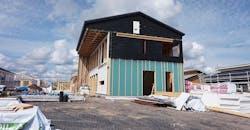(Photo: Wikimedia Commons, Tiia Monto CC by-SA 4.0)
A good tool for predicting rework and cost impact on a construction project is the Field Rework Index (FRI).
Take a past project on which you have good data on rework, waste, and costs. Then cast your mind back to the design and construction stages of that project and then score each of the questions listed below from 1 to 5, with 1 being the best rating. You can also do this evaluation as a team.
See if this score is giving an accurate estimate of rework and cost impact based on your hard data on that past project.
THEN conduct the evaluation on a current project or the initial stages of a current project and, having the accuracy evaluation from the previous FRI, see what the upcoming impact will be on this current or upcoming project.
To improve the score, simply address each of the issues addressed in each question.
- Degree of alignment between the various elements (departments, divisions, etc.) of the owner's organization
- Degree to which project execution planning was utilized
- Design teams qualifications for the specific project
- Degree to which leaders of key design disciplines have changed
- Quality of field verification of existing conditions by engineering
- Quality of interdisciplinary design coordination
- Quality of prequalification of vendors for the project
- Availability of vendor information for equipment
- Degree to which design schedule is compressed
- Level of overtime worked by the engineering firm
- Level of design rework (repeating design work)
- Commitment to constructability of the design and construction team
- Expected availability of skilled workers to the project
- Expected level of construction contractor overtime
Total Points or Field Rework Score (FRI) = ______
FRI Score
14-30 2.5% rework, 7.8% cost savings
30-45 5% rework, 6% cost growth
45-70 7% rework, 25.8% cost growth
70> High levels of rework, excessive cost growth issues
Developed by David Rogge, Oregon State University
About the Author

Denis Leonard
Denis Leonard has a degree in construction engineering, and an M.B.A. and a Ph.D. in quality management. He is a Fellow of the American Society for Quality and has been an Examiner for the Baldrige National Quality Award Board of Examiners, a Judge on the International Team Excellence Competition, and a Lead Judge on the National Housing Quality Award. He has experience as a quality manager in the home building industry as well as construction engineer, site manager, and in training, auditing, and consulting with expertise in strategic and operational quality improvement initiatives. His work has achieved national quality, environmental, and safety management awards for clients.
